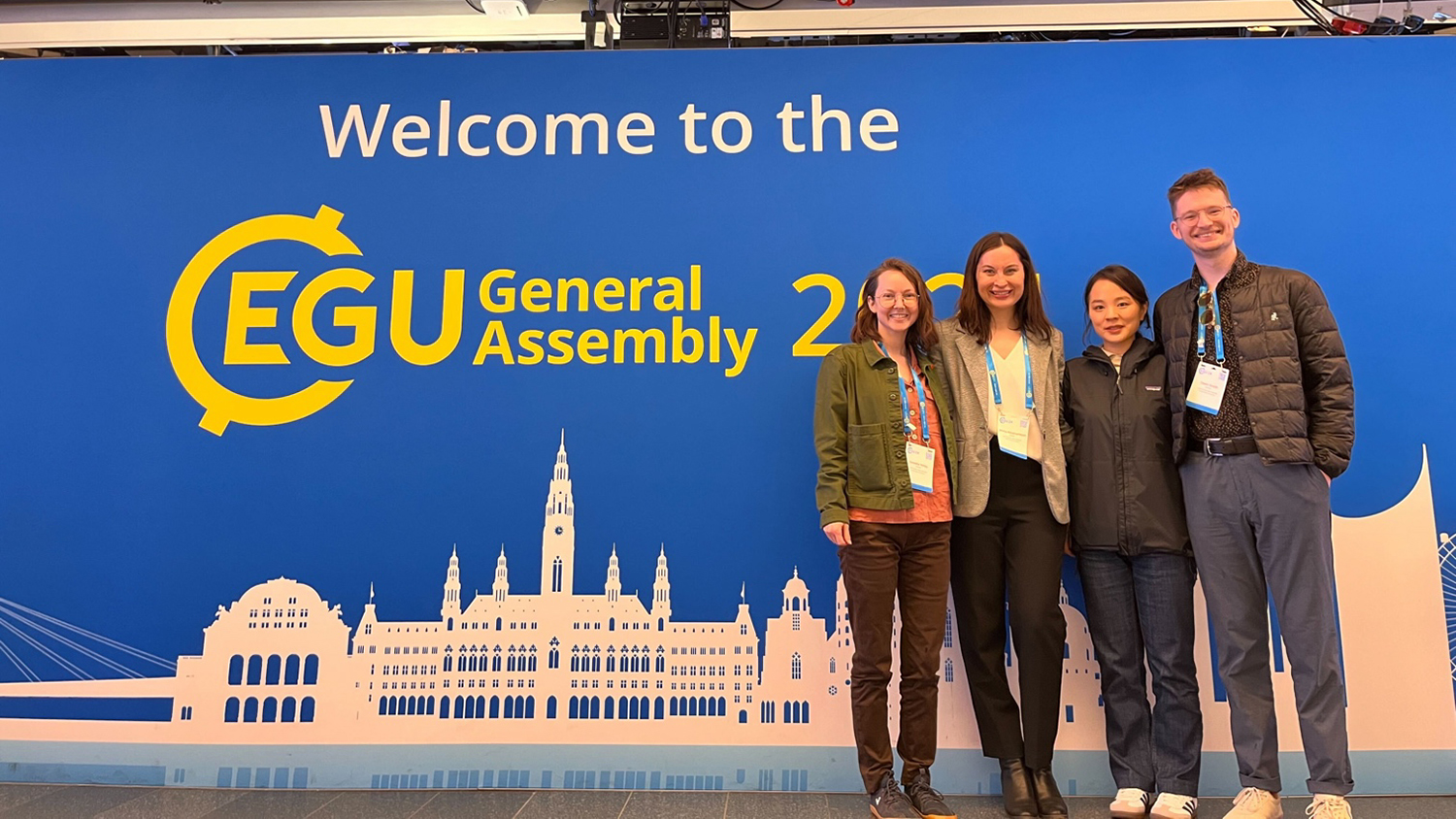GIS Problem-Solving Through Service Learning

Before graduating, each student in the Center for Geospatial Analytics’ professional master’s program in Geospatial Information Science and Technology (MGIST) applies their knowledge and skills to a client-supplied problem in a service-learning capstone project.
This semester, projects supported industry, academic, government and nonprofit partners to advance access and affordability, support local planning, keep pollution out of waterways, assess infrastructure vulnerabilities, protect health and safety and more!
Read on for a glimpse into the impactful work of our professional master’s students this Spring 2021 semester, and be sure to check out their own two-minute video summaries of their projects.
Advancing Access and Affordability

The Supplemental Nutrition Assistance Program (SNAP), helps low-income families get the healthy foods they need, and organizations like the North Carolina Alliance for Health (NCAH) advocate for better accessibility to SNAP retailers. MGIST student Justin Oakley partnered with NCAH to create a web mapping application that “shows where the retailers are, highlights disparities and shows current SNAP coverage,” he explains. The app reveals access to SNAP retailers within user-defined walking and driving distances and identifies legislative districts with SNAP disparities. Oakley is the winner of this semester’s MGIST poster competition.
“Affordable housing is a pressing concern for so many communities, with costs associated with homeownership rising, particularly in metropolitan areas like Wake County,” explains Greg Webb, who partnered with Habitat for Humanity of Wake County for his capstone. Habitat Wake has built over 750 homes in Wake County and 35 in Johnston County. The web mapping application Webb created now allows them to visualize the locations of current Habitat homes and cost-burdened populations (who spend > 30% of their take-home pay on housing), and identify desirable areas for new homes.
Supporting Local Planning

Having worked at a water utility early in his career, MGIST student William Meyers has seen firsthand how town offices can be filled with paper maps difficult to access and update. In partnership with Davie County IT/Utilities, he developed a web mapping application that can be used in the office and field to see the attributes of the county water system, plan new work and even visualize the impacts of a potential water main break. “I think this is a tremendous step forward for our public utilities,” says John Gallimore, a client partner with Davie County. “Just having the data in an operational format that is now convenient for the workers, the staff who need to use this, will be a tremendous benefit.”
Many areas across the Carolinas are experiencing rapid population growth, and GIS offers myriad ways to understand and plan for it. This semester, multiple MGIST students partnered with local governments to help them look ahead:
Chandler Fields worked with the Town of Mount Pleasant, SC, to develop a web mapping application that spatially displays building permit information; the tool he created will allow town officials to better visualize development patterns, especially in relation to location-specific costs.
Dustin Murray partnered with the Pinecroft Sedgefield Fire District to analyze the number, kind and locations of emergency calls it received over the past twenty years and map which fire stations responded to each call; the fire department will use the tools Murray created to support decisions about whether and where to add or move stations to accommodate an increasing population.
Keeping Pollution Out of Waterways

Although it provides drinking water for about 300,000 North Carolinians, Jordan Lake contains a lot of trash, 80% of which washes in from roadways and other areas upstream. MGIST student Benjamin Maxson partnered with the nonprofit Clean Jordan Lake to develop a web mapping application that assesses which roads are likely supplying the most litter and which upstream waterways would be ideal to target for preventive cleanup.
Nationwide, excess nitrogen from agricultural runoff is a big problem, contributing to oxygen-poor “dead zones” downstream. Although growers have been increasing their use of cover crops and reducing the intensity of tillage to reduce runoff, a considerable amount of farmland is rented, making it difficult for them to implement long-term, large-scale nitrogen-recapture projects. Partnering with the Environmental Defense Fund, Mandy Liesch developed a web mapping application that integrates environmental, behavioral and socio-economic data to reveal barriers to, and opportunities for, investing in infrastructure projects like artificial wetlands.
Assessing Infrastructure Vulnerabilities

Isolated coastal communities can be vulnerable to power outages, but they may also be in areas suitable for more reliable marine energy from waves and tides. MGIST student Shon Zimmerman partnered with the Pacific Northwest National Laboratory to assess the coastal energy vulnerabilities of Clallum County, WA, and identify potential locations for marine energy development to support energy resilience.
“Weight-restricted bridges are critical to the freight transportation network but may pose barriers or obstacles and create inefficiencies,” explains Chase Nicholas, a GIS Analyst at the Institute for Transportation Research and Education (ITRE). For his capstone, he expanded one of his previous projects with ITRE to identify how weight-restricted bridges in North Carolina are used in freight trucking routes serving agricultural areas.
Protecting Health and Safety

A Senior Geospatial Consultant at New Light Technologies, Brooke Hatcher partnered with her employer to advance a project she has been working on called ShelterOps. The web mapping application she developed integrates information about hospitals, shelters and potentially isolated communities for first responders and emergency planners, and even provides real-time information about road conditions using the Waze API.
Travis Newton collaborated with the international nonprofit FHI 360 to organize and visualize data on the distribution of preventive medication by USAID and the Ghana Health Ministry to fight parasitic worm infections in Ghana.
Eric Anderson partnered with NC Emergency Management to develop a method for identifying optimal sites to construct dams or levees to prevent downstream flooding in the Northeast Cape Fear Basin during intense storms.
And More!
Heather Paxson partnered with the Underwater Archaeology Branch of the NC Office of State Archaeology to upgrade how the agency tracks the locations of shipwreck debris along NC’s 300-mile coastline.

Justin Klein developed a web mapping application that will help the company GeoOwl streamline its processes for spatially matching talent with client projects.
Andrew Boschen worked with The Nature Conservancy to identify areas of NC’s coastal plain at risk from drought, flooding and wildfire and how those areas correspond to values of the CDC’s Social Vulnerability Index.
Gardner Pierson collaborated with the US Geological Survey to support its efforts in creating a highly accurate, high-resolution dataset of national surface waters called the Elevation-Derived Hydrography Dataset; he developed a suite of tools that check data submitted by independent contractors and “flag features that need to be checked by hand by USGS inspectors,” he explains.
William Parrish partnered with Recreation Resource Services and North Carolina State Parks to develop a web mapping application to assess recreation resources and needs along the Overmountain Victory National Historic Trail.
Several students collaborated with NC State partners:
Jonathan Schwartz extended the work of a Spring 2020 capstone project to track land use changes in Brazil after the construction of the Federal District in Brasilia in the mid-20th century, in collaboration with Frederico Freitas, assistant professor in the Department of History.

Matt Conard partnered with Center for Geospatial Analytics Faculty Fellow Anders Huseth (Dept. of Entomology and Pathology) to begin developing a tool that growers can use to predict annual infestation levels of agricultural insect pests and moderate insecticide use.
Kelsey Mills worked with Faculty Fellow Gustavo Machado (Dept. of Population Health and Pathobiology), extending a tool created by Machado’s lab that “provides specialized information regarding contact tracing and on-farm biosecurity to commercial swine production companies and animal health officials,” she explains.
Andrew Potter collaborated with Center for Geospatial Analytics Research Associate Okan Pala on a project to support efforts by the NC Department of Transportation to “distribute costs and benefits of infrastructure projects evenly in the areas that they’re going to be working in,” Potter says. Using ten years of census data and over 1,600 lines of JavaScript code, Potter developed a custom web mapping application that can “visualize any American Community Survey variable at any available scale” and even permit comparisons between different areas, with queries triggering on-the-fly joins and data rendering.
Thank you to all of our capstone partners, and congratulations to all of our graduating MGIST students on their success!


